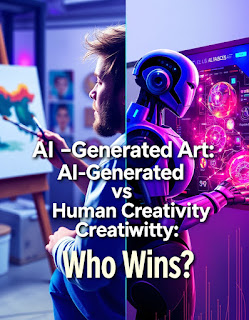In the realm of artistic creation, a fierce debate is unfolding: Can AI-generated art rival or surpass human creativity? As artificial intelligence continues to evolve, producing paintings, music, poetry, and even literature, the lines between machine and human imagination blur. But does this technological prowess mean that AI can truly replace the soul and depth of human artistry?
The Rise of AI-Generated Art
In recent years, AI-driven platforms like DALL·E, Midjourney, and Stable Diffusion have stunned the world by generating artwork that rivals—and sometimes surpasses—the visual appeal of human-made creations. These systems can produce intricate designs, surreal landscapes, and even hyper-realistic portraits based on simple text prompts.
Similarly, AI models now compose music, write poetry, and generate scripts, stirring excitement and concern across creative industries. AI-generated works have even won prizes in international art competitions, igniting controversy about the fairness of such entries.
The Strengths of AI-Generated Art
AI-generated art boasts several undeniable advantages:
Speed and Volume: AI can produce thousands of unique designs in minutes—an impossible feat for humans.
Infinite Creativity: Freed from cognitive or cultural biases, AI can combine styles, concepts, and forms in ways that are alien to human thought.
Cost Efficiency: Businesses and marketers use AI-generated visuals for logos, social media posts, and ads at a fraction of traditional costs.
Accessibility: Anyone, regardless of artistic skill, can generate professional-quality art using AI tools.
These benefits make AI an invaluable tool for industries that require high-volume, low-cost creative output.
The Irreplaceable Essence of Human Creativity
Despite its technical brilliance, AI-generated art lacks the emotional and experiential depth that characterizes human creativity:
Authentic Emotion: Human art reflects feelings, struggles, and experiences that an algorithm cannot truly understand or replicate.
Cultural Context: Artists interpret social, historical, and political realities in their work—contexts that AI may mimic but never genuinely grasp.
Intentional Imperfection: Flaws in human-made art often carry meaning or charm, something AI-generated perfection cannot replicate.
Philosophical Depth: Great art often poses existential or moral questions drawn from the artist’s life, something outside the scope of artificial systems.
Famed artists like Pablo Picasso, Frida Kahlo, or Banksy did not merely produce visuals—they conveyed narratives, pain, joy, rebellion, and commentary. These human elements remain largely absent from AI-generated pieces.
The Ethical and Legal Dilemmas
The rise of AI art introduces complex ethical and legal issues:
Copyright Infringement: AI models are trained on existing human artworks, sometimes without permission—raising serious questions about intellectual property.
Authenticity Concerns: As AI art floods the market, distinguishing original human creations from machine-made ones becomes difficult.
Job Displacement: Designers, illustrators, and musicians fear AI may devalue or replace their labor, sparking debates about the future of creative professions.
Regulatory efforts are underway, but consensus on how to manage AI’s role in art remains elusive.
Collaboration: The New Frontier
Many experts argue that the future lies not in AI replacing humans, but in collaboration. Artists increasingly use AI as a tool to expand their vision, enhance productivity, and explore new styles—blending machine efficiency with human intuition.
Examples include:
AI-assisted music production, where artists tweak and refine AI-generated melodies.
Generative art exhibitions, showcasing works that result from human-AI partnerships.
Design agencies using AI for rapid prototyping while human designers curate and perfect the results.
In this hybrid model, AI does not destroy creativity—it amplifies it.
The Verdict: Who Wins?
In the contest between AI-generated art and human creativity, there is no clear winner—only a shift in the landscape. AI offers unmatched productivity, novelty, and accessibility, while humans provide meaning, purpose, and soul.
Rather than viewing AI as a competitor, the creative world may benefit most by embracing AI as a co-creator, forging new artistic horizons that neither could achieve alone.
Conclusion: A New Era of Art and Imagination
As AI-generated art becomes more sophisticated, the role of human creativity will not diminish but evolve. The challenge for artists, designers, and thinkers in 2025 is not to resist this change, but to harness it—crafting works where technology and humanity enrich each other.
In this unfolding story, art’s future is not about machine vs. human, but about synergy—a partnership that could redefine creativity itself.

Comments
Post a Comment